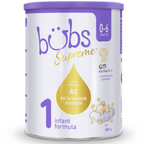A Guide To Baby Led Weaning
The process of feeding a baby can be a daunting task for any parent. For most first-time parents, ‘weaning’ or the transition from milk to solid foods can be a particularly challenging experience. From around six months, most babies are ready to take in solid foods and the process in which this occurs can vary depending on your child. Every baby is so different when it comes to wide range of factors: when to start baby led weaning, what foods they prefer etc. At the end of the day, given no child is the same, it’s important to take a lead from your baby when it comes to weaning. This is the whole concept behind baby led weaning.
What is baby led weaning?
Baby led weaning is the process of transitioning your baby from milk to solid foods by giving them the freedom to feed themselves. Instead of spoon feeding pureed foods all the time, baby led weaning encourages parents to allow their children to pick up their own food, put it in their mouth, use their tongue and jaw to chew and eat. This practice gives children control over their food, the pace at which they eat and also encourages children to be more aware of their own hunger cues.
When to start baby led weaning?
While a common age to start baby led weaning is around six months, it’s important for parents to remember that each child is unique in their development. Important cues to look for that might indicate your baby is ready to start solids might be the baby showing interest in your food, a lack of tongue-extrusion, the baby sitting upright without support, the baby grasping objects and bringing it to their mouth etc. Take the lead from your baby and gauge when they are ready in their own time.
How to start baby led weaning?
Like any milestone, it’s crucial to give your baby a safe and supervised space. Ensure your baby is sitting upright in a highchair and watch them carefully as they are eating. Start off by giving your baby small amounts of solids each day and let them lead in regards to how much they can eat. As their skills develop, you will notice they will be able to eat more and in larger pieces. Take your time and allow your baby to grow at their own pace.
What are the benefits of baby led weaning?
There are many benefits to baby led weaning when it comes to a baby’s development. The ability for your baby to hold and handle their own food allows them to become more familiar with different food textures and tastes, giving them more control over what they do and don’t like. Baby led weaning also encourages babies to develop their motor skills and become more attuned to their own hunger cues.
Baby led weaning recipes and snack ideas
When starting out with baby led weaning, it’s important to introduce a variety of foods so that your baby can adapt to different ways of eating as well as become more accustomed to various textures and tastes. Softer fruits or vegetables, like bananas, avocado, sweet potato or pumpkin are great to start with. The softer texture is easy to consume and pick up. In addition to the softer foods, it’s also recommended to give your baby small finger foods like slices of meat, beans, lentils, strips of bread etc. that they can pick up and eat on their own. There are many baby led weaning foods that you can try to integrate into your baby’s diet, keeping in mind to pay attention to their receptiveness.
Do I continue with breastfeeding and formula while baby-led weaning?
The point of baby led weaning is to slowly transition and to take your child’s lead in their feeding journey. Ultimately you do not have to stick to just one way of feeding or transition immediately. Even once you have started the baby led weaning process, you can definitely continue with breastfeeding or with milk formula while you transition. For most parents, this hybrid approach can continue until around 12 months.
At the end of the day, your baby is unique and as is their development. Baby led weaning is a wonderful way to naturally transition to solids, while giving your baby autonomy and control over their eating practices. While taking your child’s lead, it’s also important to consult with a healthcare or medical professional in order to decide on an approach that suits your family and baby.


